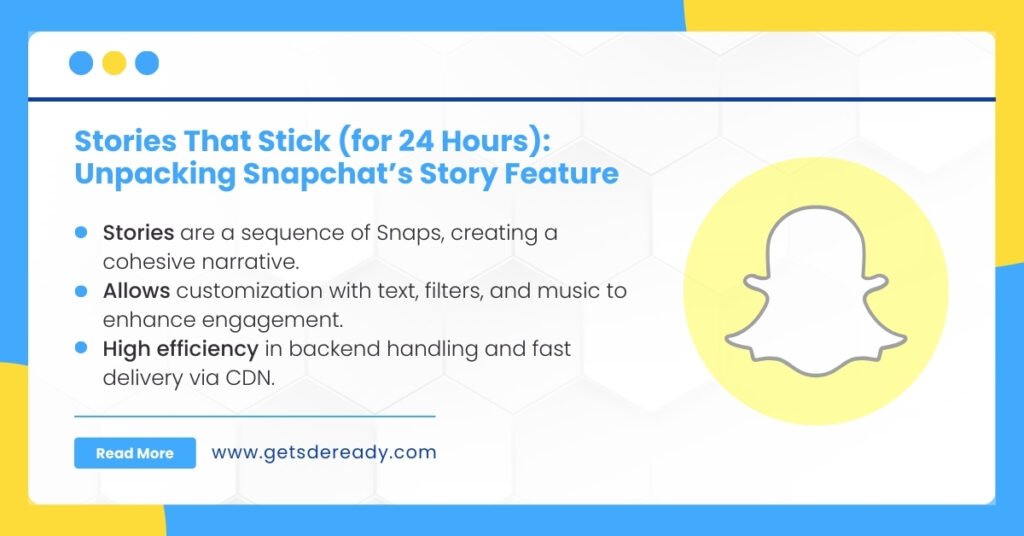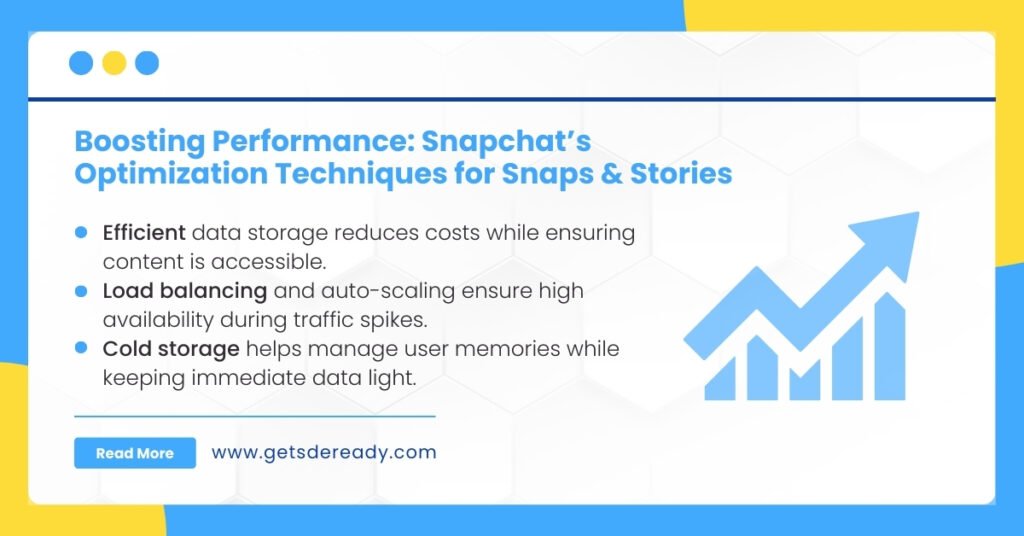
Low-Level Design of Snapchat: How Stories and Snaps Work
One of the most popular social media platforms, Snapchat has revolutionized how people interact through ephemeral content. The platform’s unique features, such as Stories and Snaps, are built on sophisticated low-level design principles that ensure scalability, performance, and user satisfaction. In this post, we will delve deep into the low-level design of Snapchat, focusing on how Stories and Snaps function.Sign up here to access exclusive insights and updates.
Introduction to Snapchat’s Architecture
Understanding Snapchat’s architecture is crucial to grasp how it handles the massive volume of user-generated content daily. Snapchat’s architecture is designed to be resilient, efficient, and user-friendly.
Key Components of Snapchat’s Backend
- User Authentication and Session Management
Snapchat employs robust authentication mechanisms to ensure secure access for millions of users.- Two-factor authentication enhances security.
- Token-based session management ensures scalability.
- Content Delivery Network (CDN)
The platform leverages CDNs to deliver Snaps and Stories quickly across geographies.- Reduces latency by caching content closer to users.
- Supports high-speed media delivery even during peak times.
- Database Design
Snapchat’s database design focuses on high availability and fast retrieval.- NoSQL databases like Cassandra for scalability.
- Real-time analytics powered by distributed systems.
Component | Purpose | Technology Used |
Authentication | Secure user access | OAuth, JWT |
CDN | Fast content delivery | Akamai, Cloudflare |
Database | High availability and real-time access | Cassandra, Redis |
Also read: Top 10 Frontend Design Questions
How Snaps Work
Snaps are Snapchat’s core feature, allowing users to share ephemeral photos and videos. Let’s explore the mechanisms that make Snaps work seamlessly.
Ephemeral Nature of Snaps
The defining feature of Snaps is their temporary availability.
- Snaps are deleted from Snapchat’s servers after being viewed.
- Metadata ensures content expiration within a set timeframe.
Snap Transmission and Encryption
Snaps are transmitted securely using advanced encryption protocols.
- End-to-End Encryption: Protects user privacy during transmission.
- Compression Algorithms: Optimize file size for faster uploads and downloads.
Key Facts:
- Over 5 billion Snaps are shared daily. (Source: Statista)
- Encryption ensures compliance with data protection regulations globally.
Technical Workflow of Snaps
- User captures a Snap using the app’s camera.
- The app applies filters and effects in real time.
- The Snap is encrypted and uploaded to the server.
- Recipient receives a notification and decrypts the Snap upon viewing.
Advantages:
- Instant sharing creates a seamless user experience.
- Encryption ensures data privacy.
Process Stage | Description |
Capture | User creates a Snap |
Encrypt | Data encrypted before upload |
Notify | Recipient alerted about the Snap |
Expire | Snap auto-deletes after viewing |
Also read: Top 15 DSA Questions on Arrays & Strings
How Stories Work

Stories extend the concept of Snaps by allowing users to share multiple Snaps as a cohesive narrative. These Stories remain visible for 24 hours.
Story Creation and Structure
Stories are made up of sequential Snaps, creating a timeline.
- Users can add text, filters, and music to each Snap.
- Stories are accessible to selected friends or the public.
Backend Handling of Stories
Snapchat’s backend manages Stories with high efficiency.
- Stories are stored temporarily using a scalable cloud infrastructure.
- Metadata tracks the expiration time for each Story.
Workflow of Stories:
- User uploads Snaps to their Story.
- Backend generates thumbnails for fast previews.
- The CDN caches Story content for efficient delivery.
Step | Description |
Upload | User adds Snaps to Story |
Process | Thumbnails and metadata generated |
Deliver | Content cached and streamed via CDN |
Expire | Story auto-deletes after 24 hours |
Challenges in Story Design
Building the Story feature required addressing unique challenges.
- High bandwidth usage due to large media files.
- Ensuring seamless playback across devices.
Solutions:
- Adaptive bitrate streaming ensures smooth video playback.
- Distributed storage systems handle high data loads.
Also read: Top 10 Cloud App Design Questions
Optimizing Snap and Story Performance

Snapchat constantly optimizes its platform to handle billions of Snaps and Stories daily.
Efficient Data Storage
Snapchat’s storage system is designed for ephemeral content.
- Data is stored temporarily to minimize costs.
- Cold storage is used for memories saved by users.
Key Features:
- Efficient storage allocation reduces latency.
- Temporary content deletion aligns with user expectations.
Load Balancing and Scalability
Load balancers play a critical role in Snapchat’s performance.
- Requests are evenly distributed across servers.
- Auto-scaling ensures resources are added dynamically during high traffic.
Recommended Topic: Top 10 Distributed System Design Challenges
Feature | Benefit |
Temporary Storage | Reduces server costs |
Load Balancers | Ensures high availability |
Auto-Scaling | Handles traffic spikes effectively |
Security and Privacy Measures

Security and privacy are at the core of Snapchat’s design philosophy.
User Data Protection
Snapchat implements advanced measures to safeguard user data.
- Encryption ensures data privacy.
- Limited data retention policies enhance security.
Facts:
- Over 80% of users trust Snapchat with their private content. (Source: Business Insider)
- Snapchat complies with GDPR and other global data protection laws.
Preventing Unauthorized Access
Snapchat employs multiple layers of security to prevent unauthorized access.
- AI-driven algorithms detect and block suspicious activities.
- Session timeouts prevent unauthorized account usage.
Advantages:
- Strengthens user trust in the platform.
- Protects against data breaches and leaks.
Also read: Top 20 DSA Questions for 2025 Interviews
FAQs
How does Snapchat manage real-time updates for Stories?
Snapchat employs event-driven architecture and real-time messaging protocols to ensure Stories are updated instantly. This design optimizes user engagement and interaction.
What is the role of caching in Snapchat’s Snaps?
Caching allows Snapchat to reduce server load and improve speed by storing frequently accessed data locally. This enhances the app’s performance and user experience.
Can I learn the concepts behind Snapchat’s design?
Yes! Explore our expertly curated courses on DSA, Web Development, and System Design to master these concepts.
What makes Snapchat’s Stories unique from other platforms?
Snapchat Stories stand out due to their ephemeral nature, enhanced security protocols, and seamless synchronization powered by advanced design principles.
Where can I learn to design apps like Snapchat?
Our comprehensive courses, such as the Master DSA, Web Dev, and System Design and Data Science, are perfect for understanding such advanced designs.
Accelerate your Path to a Product based Career
Boost your career or get hired at top product-based companies by joining our expertly crafted courses. Gain practical skills and real-world knowledge to help you succeed.
Reach Out Now
If you have any queries, please fill out this form. We will surely reach out to you.
Contact Email
Reach us at the following email address.
arun@getsdeready.com
Phone Number
You can reach us by phone as well.
+91-97737 28034
Our Location
Rohini, Sector-3, Delhi-110085








